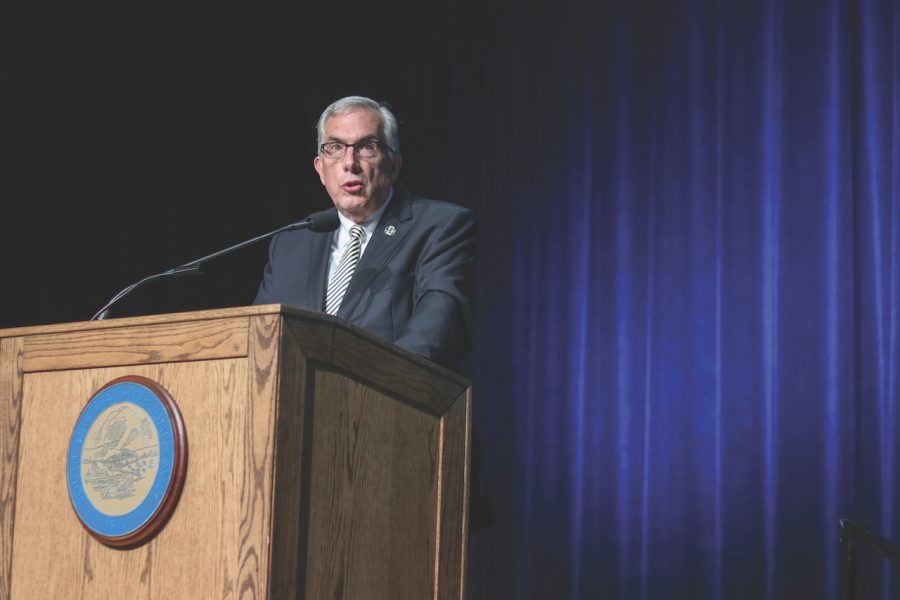Dunn address enrollment, Imagine 2023 in State of the University
September 12, 2019
On Tuesday, Sept. 10, South Dakota State University President Barry Dunn stepped up to the podium to give a State of the University Address, where the topics covered were highlighted by declining enrollment and possible solutions.
While the enrollment figures haven’t been released by the South Dakota Board of Regents (SDBOR) yet this year, those figures will be related later this month, according to Dunn.
“As we rely more on tuition and fees and enrollment declines, we will need to continue to reduce the size of our overall university budget,” Dunn said. “In other words, we have fewer dollars to operate the university.”
Dunn addressed the issues that have plagued enrollment recently.
Legislatively mandated drop in credit hours
Dunn noted a legislative change that lowered the credit hour requirement from 128 to 120 for most programs.
Heavily subsidized AP and dual-credit courses
Another variable that has been impacting enrollment but is out of the administration’s hands is the number of students arriving on campus having already earned college credits.
“It’s not unusual for high school students to bring with them a semester’s worth of general education courses when they arrive on campus,” Dunn said.
Federal policies related to international students
Dunn also addressed the decline of international students attending SDSU and recognized that the issue is something that the administration doesn’t have a say in.
“This is certainly an area that remains sensitive and out of our control,” Dunn said.
Despite the drop, Dunn and university administration are focused on recruiting international students and boosting those numbers.
“We will continue to achieve growth in this area because of the benefits that international students bring to our community,” Dunn said.
Drop in Pell Grant eligible students
In the past eight years, there has been a 9% decrease in students who qualify for Pell Grants. Last year, the figure that was reported to the administration was 22%.
“(The drop) translates into over 1,000 students, who have the highest financial need, but have been priced out of attendance by the subtle decline in state support for higher education, and the lack of a needs-based scholarship in South Dakota,” Dunn said.
Another issue that was highlighted by Dunn was the drop in South Dakota residents attending SDSU. However, students from Nebraska increased — a trend that Dunn attributed to the lowering of tuition.
“It is crystal clear to me, that [the] challenge will continue for many years,” Dunn said. “But, we are succeeding in many important areas.”
Graduation Rate Increase
According to Dunn, 2,883 baccalaureate degrees were conferred last year, the second-highest figure in the school’s history. Four-year graduation rates also increased by 6% from last year. Retention rates were also up this past year, with SDSU retaining 79% of the student population.
“These metrics are proof that we are achieving the goals set forth by our South Dakota Board of Regents to graduate students on time at a lower cost and get them into the workforce,” Dunn said.
“Wokini is working,” Dunn said, mentioning that the Wokini Initiative helped applications among Native Americans nearly double from fall 2018 to fall 2019.
Higher Learning Commission
Dunn also announced that the Higher Learning Commission will be visiting the university Nov. 4-5. SDSU has been an accredited institution since 1916, according to Dunn.
“This is a critical process for the continued success for our university,” Dunn said.
Program Accreditation
Currently, South Dakota State University boasts 47 accredited programs. In the past six years, 15 programs earned accreditation. Dunn set the goal to obtain 61 accredited programs by the end of 2023.
“(This is) something that is attainable with continued efforts including several programs already on their way to being accredited,” Dunn said.
Dunn also recognized different members of the university. Among the highlighted were the University Police Department, the women’s basketball team, Dr. Adam Hoppe and Facilities and Services.
“We prepare the leaders of tomorrow to solve the wicked problems of the 21st century, related to food, energy, water, climate change and population growth,” Dunn said. “We do important life-changing work.”
























